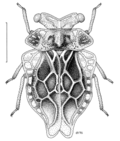Hemiptera: Difference between revisions
CSV import |
CSV import |
||
| Line 38: | Line 38: | ||
{{stub}} | {{stub}} | ||
{{dictionary-stub1}} | {{dictionary-stub1}} | ||
<gallery> | |||
File:Hemiptera_suborders.jpg|Hemiptera suborders | |||
File:Fulgoroidea_Crato_Formation_Brazil.jpg|Fulgoroidea Crato Formation Brazil | |||
File:Annualreportofag1119021903univ_0052AA2_Figure_1.jpg|Annual report of agriculture 1902-1903 Figure 1 | |||
File:Psocoptera_icon.png|Psocoptera icon | |||
File:Taeniothrips_inconsequens.jpg|Taeniothrips inconsequens | |||
File:Aphid_icon.png|Aphid icon | |||
File:Bug_(PSF).jpg|Bug (PSF) | |||
File:HEMI_Peloridiidae_Oiophysa_distincta_1.png|HEMI Peloridiidae Oiophysa distincta | |||
File:Acanaloniidae.jpg|Acanaloniidae | |||
File:Marbaarus_bubalus_Distant.jpg|Marbaarus bubalus Distant | |||
File:HemipteraMouthparts.jpg|Hemiptera Mouthparts | |||
File:Milkweed_bug_drilling.webm|Milkweed bug drilling | |||
</gallery> | |||
Latest revision as of 21:23, 23 February 2025
Hemiptera is an order of insects often referred to as the true bugs. They are characterized by their sucking mouthparts and their two pairs of wings, the front pair of which is thickened and leathery. Hemiptera includes a variety of species, many of which are significant in agriculture as pests or beneficial insects.
Characteristics[edit]
Hemiptera are distinguished by their unique mouthparts that are adapted for piercing and sucking. They have a pair of compound eyes, and in some species, there are also simple eyes known as ocelli. The order is divided into two suborders: Heteroptera and Homoptera, based on the variation in their wing structure.
Classification[edit]
The order Hemiptera is divided into three suborders: Auchenorrhyncha, Sternorrhyncha, and Heteroptera. Each of these suborders is further divided into families, genera, and species.
Ecology and Life Cycle[edit]
Hemiptera are found in a wide range of habitats, from aquatic to terrestrial. They play various roles in the ecosystem, including being predators, parasites, and plant feeders. The life cycle of Hemiptera includes egg, nymph, and adult stages.
Economic Importance[edit]
Many species of Hemiptera are economically important due to their role as pests in agriculture. Some species, such as aphids, can cause significant damage to crops. On the other hand, some species are beneficial, acting as natural predators to other insect pests.
Control Methods[edit]
Control methods for Hemiptera pests include chemical pesticides, biological control, and integrated pest management strategies.
See Also[edit]
References[edit]
<references />
|
|
|
-
Hemiptera suborders
-
Fulgoroidea Crato Formation Brazil
-
Annual report of agriculture 1902-1903 Figure 1
-
Psocoptera icon
-
Taeniothrips inconsequens
-
Aphid icon
-
Bug (PSF)
-
HEMI Peloridiidae Oiophysa distincta
-
Acanaloniidae
-
Marbaarus bubalus Distant
-
Hemiptera Mouthparts
-
Milkweed bug drilling












